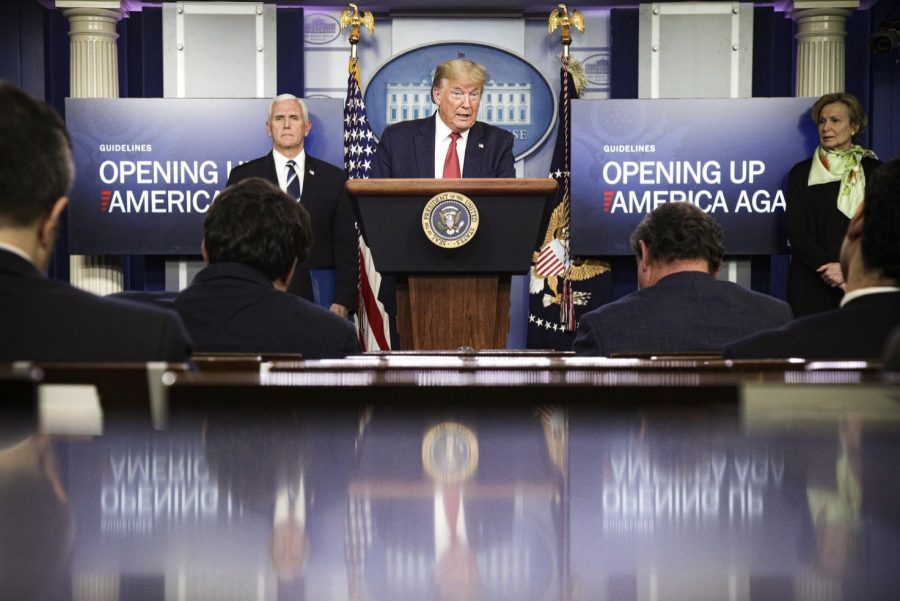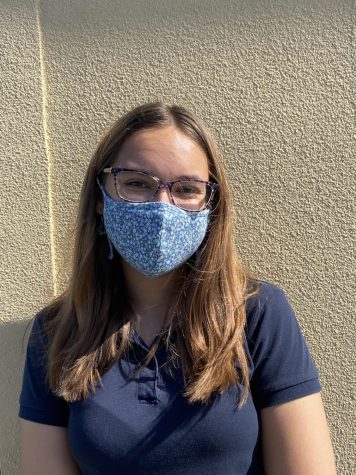The Phases of Opening America Back Up
Trump speaking at the White House daily briefing
April 29, 2020
On April 16th, Trump unveiled Guidelines for Opening Up America Again, a three-phased approach that is meant to guide state and local officials, as well as the public, along the journey of reopening America. Guidelines for Opening Up America Again aims to “help state and local officials when reopening their economies, getting people back to work, and continuing to protect American lives,” according to the White H0uses website. It also highlights under which circumstances America will open up again, which is the “gating criteria.”
K.C. Rondello, clinical associate professor at Adelphi University’s College of Nursing and Public Health, in New York, told Newsweek that “In terms of the phased approach, I think it is a smart approach to reopening America. America is not a light switch, it’s a dimmer switch.” He also added that “another plus is that it encourages regions to work together and I think that is important because this virus does not recognize arbitrary political boundaries.”
According to the White House website, before any of the phases take place, in regards to symptoms, states must have “a downward trajectory of influenza-like illnesses reported within a 14 day period and [a] downward trajectory of covid-like syndrome cases reported within the the same 14 day period.” Next, in regards to cases, states must have a “downward trajectory of documented cases within a 14-day period or [a] downward trajectory of positive tests within a 14-day period (flat or increasing volume of tests.” Lastly, in regards to hospitals, states must be able to “treat all patients without crisis care and [have a] robust testing program in place for at-risk healthcare workers, including emerging antibody testing.”
It might seem a little early to discuss reopening America with the influx of cases, as Dr. Anthony Fauci from the White House Coronavirus Task Force warned that “unless we get the virus under control, the real recovery economically is not gonna happen.” Yet, according to Trump, “now that we have passed the peak in new cases, we are starting our life again,” adding that “we are starting rejuvenation of our economy again.”
The Guidelines for Opening Up America Again also outline the Core State Preparedness Responsibilities, which includes requirements for testing and contact tracing and healthcare system capacity, as well as what the phases plan on achieving, such as monitoring conditions and protecting employees and users of mass transit.
Upon meeting the requirements, states can follow the three-phased guideline to open their economies back up. Phase one includes three sub-categories, one for individuals to follow, one for employers, and one for specific types of employers. The category for individuals includes the continuance of self-quarantine for vulnerable individuals (elderly individuals, individuals with serious underlying health conditions, or those whose immune system is compromised), the avoidance of social settings of more than 10 people where appropriate distancing may not be practical (unless precautionary measures are observed), minimizing non-essential travel, and maximizing distance from others when individuals are in public.
Phase two is for states with no evidence of a rebound and that meet the gating criteria the second time. Phase two also includes the three sub-categories, one for individuals, one for employers, and one for specific types of employers. Vulnerable individuals should still self-quarantine and all individuals should still maximize physical distance from others. Yet now, in phase two, social settings of more than 50 people, where appropriate distancing may not be practical, should be avoided (unless precautionary measures are observed) and non-essential travel can resume.
Phase three is for states with no evidence of a rebound and that meet the gating criteria a third time and also includes the three sub-categories. Now, vulnerable individuals can resume public interactions while practicing physical distancing and minimizing exposure to social settings where distancing may not be practical (unless precautionary measures are observed). Also, phase three highlights that low risk populations should consider minimizing time spent in crowded environments.
“This is not a country that was built for this. It was not built to be shut down,” Trump said. “America will, again, and soon, be open for business. Very soon. A lot sooner than three or four months that somebody was suggesting. Lot sooner. We cannot let the cure be worse than the problem itself.”


